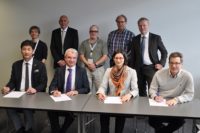“Wouldn’t it be great, if machines could communicate in a direct way with each other? This idea is at the core of the Industry 4.0 movement to create the smart factory of the future. The goal of reaching "interoperability" is the new core competence that must distinguish our future products in a connected world of Industrial IoT - but even more, the acting people and organizations involved. As chairman of the VDMA OPC Machine Vision Initiative and its working group, I am proud that Machine Vision plays a pioneering role and as one of the first VDMA divisions, is presenting the release of an OPC UA Companion Specification to the public, thanks to the extraordinary commitment and cooperation by the core working group members who worked very hard and made it possible,” says Dr. Horst Heinol-Heikkinen, Managing Director of ASENTICS and board member of VDMA Robotics and Automation and VDMA Machine Vision.
Stefan Hoppe, President and Executive Director of the OPC Foundation commented: "The OPC Foundation truly appreciates the results of the VDMA OPC Machine Vision initiative. The initiative has taken a decisive step forward into the Industry 4.0 era that is second to none. Beyond the work done to adopt OPC UA as the interoperability platform for Machine Vision, we applaud the joint working group for embracing the spirit of inter-organizational collaboration on a global scale with G3. This ‘big thinking’ aligns well with a key OPC Foundation focus on encouraging organizations to work together to reduce the vast number of overlapping ‘custom’ information models into a harmonized set of OPC UA Companion Specifications. This will benefit end-users and vendors around the world by lowering the barriers in the way of true interoperability.”
VDMA OPC Machine Vision initiative – teamwork with maximum impact
In January 2016, the VDMA Machine Vision Board decided to develop an OPC UA Companion Specification for Machine Vision. The work has been carried out within the joint working group, which consists by definition, of the OPC Foundation and a host organization, which is VDMA Machine Vision, a sector group within the VDMA Robotics + Automation association. A core working group with 17 experts from leading European machine vision companies took on the pioneering challenge, came up with proposals for the approach and contents and monitored the feedback from the wider machine vision industry and end-users worldwide.
To have broader reach, VDMA Machine Vision decided to bring this important standardization work into the global standardization cooperation for Machine Vision called G3. This G3-cooperation consists of the American (AIA), Chinese (CMVU), European (VDMA and EMVA) and Japanese (JI-IA) trade associations acting around the world. “Worldwide, the machine vision community has had the chance to contribute to the contents of the OPC UA Machine Vision companion specification – which will now lead to a broad acceptance and uptake of the new standard”, says Dr. Heinol-Heikkinen.
In total, 35 days of face-to-face meetings, about 50 online meetings and countless individual working hours of the Working Group now comes to an end with the release of the OPC UA Machine Vision Companion Specification Part 1. It is now available for download at the OPC Foundation Website and on the VDMA Website.
The OPC UA companion specification part 1
Part 1 describes an abstraction of the generic vision system, i.e. a representation of a so-called "digital twin" of the system. It handles the management of recipes, configurations and results in a standardized way, whereas the contents stay vendor-specific and are treated as black boxes.
It allows the control of a vision system in a generalized way, abstracting the necessary behavior via a state machine concept. A test implementation has already been successfully completed and was presented to a large audience of automotive engineering experts at a major event of the automotive industry in Germany dedicated to OPC UA in May 2019. A hardware demonstrator is now being developed which will be showcased at major trade shows in Germany soon. And, as the addition “part 1” indicates: the work of the VDMA OPC Machine Vision Initiative does not stop here. In addition, Part 1 establishes a kind of infrastructure layer that enables a simplified and uniform integration of all possible image processing systems into higher IT production systems (PLC, SCADA, MES, ERP, Cloud, ...). The idea is that beyond Part 1, other proprietary elements are broken down and replaced by standardized information structures and semantics, such as configuration, recipe and result information.
For more information, visit www.vdma.com/vision or https://opcfoundation.org/.






